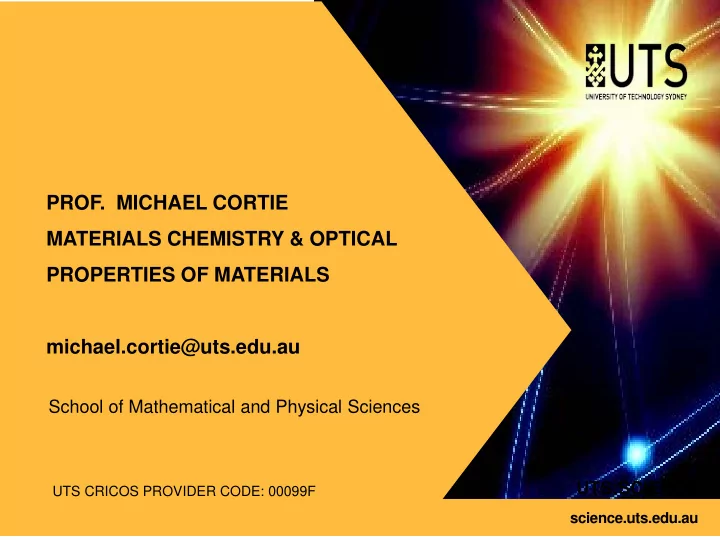

PROF. MICHAEL CORTIE MATERIALS CHEMISTRY & OPTICAL PROPERTIES OF MATERIALS michael.cortie@uts.edu.au School of Mathematical and Physical Sciences UTS:SCIENCE UTS CRICOS PROVIDER CODE: 00099F science.uts.edu.au
CAPABILITIES Synthesis and characterization of: • metallic alloys • intermetallic compounds, • functional inorganic compounds Optical properties of materials • plasmonics • spectrally selective coatings Mathematical modelling • basic DFT • Monte Carlo studies • electromagnetic simulations • molecular dynamics simulations science.uts.edu.au
CASE STUDY 1 – NANOCRYSTALLINE ZINC OXIDE ZnO has a very wide range of industrial and consumer applications Some requirements are for nanocrystalline particles Together with multi- national client we developed new methods to manufacture such materials science.uts.edu.au
CASE STUDY 2 – COATINGS FOR ENHANCED RADIATIVE HEAT TRANSFER There is a special range of infrared wavelengths through which the sky is especially transparent By manipulating the emissivity of a coating material as a function of wavelength, it becomes possible to have coatings that ‘pump’ heat out into the sky. Significant cooling of a roof or building can be achieved in this way. We have had several industrial consultancies on this topic. science.uts.edu.au
CASE STUDY 3 – MATHEMATICAL MODELLING OF FORMATION OF MESOPOROUS METALLIC CATALYSTS Nanoporous sponges of gold, platinum and silver can be made by de- alloying a precursor alloy. These have potential applications as catalysts, sensor electrodes , SERS substrates, spectrally-selective optical coatings, and actuators. We have worked extensively in this area, by making, characterizing and modelling these sponges. We have had an industry-funded project on this topic. science.uts.edu.au
CASE STUDY 4. ELECTROMAGNETIC SIMULATIONS Effect of surface roughness on the reflectance of Ag-Al mirrors. (Surface enhanced Raman substrates, mirrors for LEDs, spectrally- selective coatings, plasmonic devices) Ab initio modelling and experimental verification: 1. Calc optical properties by Density Functional theory then check against experiments 2. Construct high resolution geometric models of surface then determine effect of light. science.uts.edu.au
CONTACTS Materials science & engineering, and materials chemistry Prof Michael Cortie michael.cortie@uts.edu.au Prof. Guoxiu Wang guoxiu.wang@uts.edu.au Dr Paul Thomas paul.thomas@uts.edu.au Optical properties of materials, built environment, physics Prof. Geoffrey Smith geoff.smith@uts.edu.au Dr Matthew Arnold matthew.arnold-1@uts.edu.au Dr Angus Gentle angus.gentle@uts.edu.au Dr Annette Dowd annette.dowd@uts.edu.au Medicinal chemistry, synthetic chemistry A/Prof. Alison Ung alison.ung@uts.edu.au A/Prof Andrew McDonagh andrew.mcdonagh@uts.edu.au Dr Tristan Rawling tristan.rawling@uts.edu.au Battery technology, energy materials Prof. Guoxiu Wang guoxiu.wang@uts.edu.au science.uts.edu.au
Recommend
More recommend